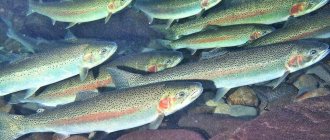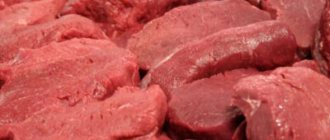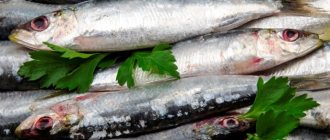A healthy diet must include fish dishes, which are tasty and nutritious, and most importantly, healthy, as they are rich in vitamins, minerals and Omega fatty acids. Catfish, which lives in the northern seas, is considered to be just such a fish. To survive in the harsh conditions of the north, it accumulates large amounts of fat. Therefore, such fish, especially blue catfish, have a delicate, mild taste. It is also in demand because there are no small bones in the catfish family. Another feature of the meat of this fish: it is loose and watery.
Properties of catfish
Nutritional value and composition | Vitamins | Minerals
How much does catfish cost (average price for 1 kg)?
Moscow and Moscow region.
320 rub.
Catfish, a perch-like fish, also has a second name - sea wolf, which is found as often as the main name of this fish. Catfish is quite common in Russia, so various dishes are made from it quite often.
It goes well with cereals, potatoes and vegetables; many people prefer to bake it in foil or grill it; when cooked this way, it has a special piquancy. Catfish often reaches its maximum weight - more than 30 kilograms, and its size is also large - from one meter to one and a half meters long.
The preferences of the sea wolf include moderate and cold waters, as well as soil that is overgrown with algae; they usually live at a depth of 300-600 meters. Catfish meat is incredibly juicy and tender; this fish will be a real find for true connoisseurs of fish dishes.
Catfish calories. Chemical composition and nutritional value.
Nutritional value and chemical composition of catfish.
The table shows the nutritional content (calories, proteins, fats, carbohydrates, vitamins and minerals) per 100 grams of edible portion.
| Nutrient | Quantity | Norm** | % of the norm in 100 g | % of the norm in 100 kcal | 100% normal |
| Calorie content | 126 kcal | 1684 kcal | 7.5% | 6% | 1337 g |
| Squirrels | 19.6 g | 76 g | 25.8% | 20.5% | 388 g |
| Fats | 5.3 g | 56 g | 9.5% | 7.5% | 1057 g |
| Water | 74 g | 2273 g | 3.3% | 2.6% | 3072 g |
| Ash | 1.1 g | ~ | |||
| Vitamins | |||||
| Vitamin A, RE | 60 mcg | 900 mcg | 6.7% | 5.3% | 1500 g |
| Retinol | 0.06 mg | ~ | |||
| Vitamin B1, thiamine | 0.24 mg | 1.5 mg | 16% | 12.7% | 625 g |
| Vitamin B2, riboflavin | 0.04 mg | 1.8 mg | 2.2% | 1.7% | 4500 g |
| Vitamin B6, pyridoxine | 0.33 mg | 2 mg | 16.5% | 13.1% | 606 g |
| Vitamin C, ascorbic acid | 1.4 mg | 90 mg | 1.6% | 1.3% | 6429 g |
| Vitamin E, alpha tocopherol, TE | 0.4 mg | 15 mg | 2.7% | 2.1% | 3750 g |
| Vitamin RR, NE | 5.8 mg | 20 mg | 29% | 23% | 345 g |
| Niacin | 2.5 mg | ~ | |||
| Macronutrients | |||||
| Potassium, K | 335 mg | 2500 mg | 13.4% | 10.6% | 746 g |
| Calcium, Ca | 30 mg | 1000 mg | 3% | 2.4% | 3333 g |
| Magnesium, Mg | 35 mg | 400 mg | 8.8% | 7% | 1143 g |
| Sodium, Na | 100 mg | 1300 mg | 7.7% | 6.1% | 1300 g |
| Sera, S | 190 mg | 1000 mg | 19% | 15.1% | 526 g |
| Phosphorus, P | 180 mg | 800 mg | 22.5% | 17.9% | 444 g |
| Chlorine, Cl | 165 mg | 2300 mg | 7.2% | 5.7% | 1394 g |
| Microelements | |||||
| Iron, Fe | 0.5 mg | 18 mg | 2.8% | 2.2% | 3600 g |
| Yod, I | 5 mcg | 150 mcg | 3.3% | 2.6% | 3000 g |
| Cobalt, Co | 20 mcg | 10 mcg | 200% | 158.7% | 50 g |
| Manganese, Mn | 0.03 mg | 2 mg | 1.5% | 1.2% | 6667 g |
| Copper, Cu | 70 mcg | 1000 mcg | 7% | 5.6% | 1429 g |
| Molybdenum, Mo | 4 mcg | 70 mcg | 5.7% | 4.5% | 1750 g |
| Nickel, Ni | 6 mcg | ~ | |||
| Fluorine, F | 430 mcg | 4000 mcg | 10.8% | 8.6% | 930 g |
| Chromium, Cr | 55 mcg | 50 mcg | 110% | 87.3% | 91 g |
| Zinc, Zn | 0.6 mg | 12 mg | 5% | 4% | 2000 g |
| Sterols (sterols) | |||||
| Cholesterol | 80 mg | max 300 mg | |||
| Saturated fatty acids | |||||
| Saturated fatty acids | 0.9 g | max 18.7 g | |||
| 16:0 Palmitinaya | 1.18 g | ~ | |||
| 18:0 Stearic | 0.21 g | ~ | |||
| 20:0 Arakhinovaya | 0.15 g | ~ | |||
| Monounsaturated fatty acids | 1.85 g | min 16.8 g | 11% | 8.7% | |
| 16:1 Palmitoleic | 0.58 g | ~ | |||
| 17:1 Heptadecene | 0.03 g | ~ | |||
| 18:1 Oleic (omega-9) | 1.21 g | ~ | |||
| 20:1 Gadoleic (omega-9) | 0.03 g | ~ | |||
| Polyunsaturated fatty acids | 0.64 g | from 11.2 to 20.6 g | 5.7% | 4.5% | |
| 18:2 Linolevaya | 0.06 g | ~ | |||
| 18:3 Linolenic | 0.01 g | ~ | |||
| 20:4 Arachidonic | 0.09 g | ~ | |||
| 20:5 Eicosapentaenoic acid (EPA), Omega-3 | 0.42 g | ~ | |||
| Omega-3 fatty acids | 0.5 g | from 0.9 to 3.7 g | 55.6% | 44.1% | |
| 22:5 Docosapentaenoic acid (DPA), Omega-3 | 0.06 g | ~ | |||
| Omega-6 fatty acids | 0.2 g | from 4.7 to 16.8 g | 4.3% | 3.4% |
The energy value of catfish is 126 kcal.
Primary Source: Created in the application by the user. Read more.
** This table shows the average levels of vitamins and minerals for an adult. If you want to know the norms taking into account your gender, age and other factors, then use the “My Healthy Diet” application.
The benefits of catfish
The benefit of catfish is that it contains a large amount of useful substances, trace elements, minerals and vitamins. Despite the fact that catfish meat is quite fatty, 100 grams contains 5.3 grams of fat, it contains very healthy fatty acids that are necessary for the human body.
Also, the beneficial properties of catfish have contributed to its spread in cooking, precisely because its meat is so healthy, Russian residents are increasingly using it in their dishes, making them not only unusual in taste, but also beneficial in their effect on the human body. The benefits of catfish are due to its high nutritional value, and its meat is perfectly absorbed in the human body, so many recommend eating it for diseases of the thyroid gland.
The beneficial properties of catfish are absolutely irreplaceable for athletes, since it is an excellent source of protein, which is so needed during training and competitions. The absorption of this protein occurs quickly and very easily. Sea wolf contains many vitamins, minerals and amino acids, which have a beneficial effect on the cardiovascular system and help normalize its functioning. The calorie content of catfish is low, so there is no danger of obesity.
Description
Catfish is the general name of a family of marine fish, including two genera and five species. All catfish are included in the order Perciformes, although outwardly they are not at all similar to them. They rather resemble eels or moray eels, with an elongated and rather large body. A characteristic feature of the fish are protruding fangs, like those of a dog . The mouth contains many small teeth designed for crushing food.
Adult representatives weigh about 30 kg with a body length of 120-200 cm. Catfish is popular in cooking due to its excellent taste, high nutritional value and a number of beneficial properties. The following varieties of catfish are of greatest commercial importance:
- blue (widow);
- Far Eastern;
- spotted;
- striped;
- acne.
The fish meat has a delicate texture and is considered a delicacy. It usually goes on sale in frozen and fresh (chilled) condition, without heads and scales. It also comes in hot smoked form.
Tips for choosing the right fish
Catfish must be chosen correctly so that its consumption brings exceptional benefits to the body. You need to adhere to the following recommendations:
- The eyes should be clear and prominent. This is the main indicator of freshness. You should not buy catfish with cloudy or sunken eyes, and it is also better to refrain from buying fish without eyeballs at all (unscrupulous sellers remove them on purpose).
- Smooth, shiny and tightly pressed fish skin is another indicator of quality. It is better not to take catfish with defects, as it is stale.
- The gills should be pink or red in color, without mucus, and with a natural fishy odor. If they have a brown or beige tint, then the catfish is at least a week old.
- Poor quality is indicated by a mucus-covered or swollen belly. This indicates that the catfish was not stored correctly.
- When pressed, the carcass should quickly return to its original shape, dents should not remain, stickiness and slipperiness are unacceptable. Otherwise, there is a suspicion that the seller is trying to sell long-stored catfish.
If you can’t get fresh catfish, you can buy frozen. In this case, you need to check the packing date. If more than 2 months have passed since this moment, it is better to refuse the purchase. The beneficial properties of fish have already begun to be lost.
It is important to store catfish properly. A fresh carcass should not be kept in the refrigerator for more than 1–1.5 days. The ideal option is to start cooking immediately after purchase. Frozen catfish can be kept in the freezer for 2 months from the date of freezing, but no longer.
Recipe? Recipe!
Steamed catfish:
Ingredients for 6 servings:
500 g fish, 1 tbsp. spoon of lemon juice, ground black pepper, salt.
Preparation: 20 min.
Separate the catfish meat from the bones and cut it into large pieces. Prepare the marinade: mix lemon juice with salt and pepper. Pieces of fish are dipped in the marinade for 10 minutes. Each piece of marinated fish is then wrapped in foil and placed in the slow cooker on a steamer dish. Set the “Steaming” mode (cooking time 15–20 minutes: the larger the fish, the longer it takes to cook). After the process is completed, unroll the foil and place the finished fish on a plate, pour juice from the bowl on top.
A couple of secrets for cooking catfish:
- To cook steaks from it, first salt them well and let them sit for about 30 minutes, then drain the released liquid and pat the steaks well. The salt will draw out excess water. Fry the steaks until golden brown, turning only once.
- This fish often falls apart when fried, so it is better to cook it like this: cut the fillet into small pieces, blanch in well-salted water (to make the meat denser) for a couple of minutes, cool, roll in flour and then fry.
- Since its meat easily loses its shape when fried, it is better to prepare cutlets from it, which turn out very juicy. It is not recommended to fry them; it is better to bake them in the oven so that they do not fall apart when turned over.
- A very tasty dish made from “capricious” catfish – gratin. Layer thin round potato slices, fish fillet slices and onion rings into a greased baking dish, seasoning the layers with salt and pepper. Brush the surface of the gratin with sour cream and sprinkle with grated cheese, then bake in the oven.
Beneficial features
The fatty meat of the sea wolf contains a large amount of potassium, which promotes the timely removal of salts from the body. And fatty acids have a beneficial effect on cells and participate in the process of their rejuvenation. With regular consumption of catfish, the functioning of the cardiovascular system improves, blood pressure and blood clotting are normalized. Moreover, this type of sea fish should be present in the diet of people who have problems with the gastrointestinal tract.
How to select and store catfish
1. It is best to buy fresh or chilled fish, this way you can more accurately determine the condition of the fish. In addition, if you cook meat from frozen, it simply “spreads” into pieces.
2. First of all, pay attention to the eyes, they should be clean, not cloudy.
3. When pressed, the meat of fresh fish is quickly restored. Fresh catfish is slippery, does not stick to your hands, and has smooth scales.
4. The gills are without mucus and pink in color; in stale fish they take on a brown tint.
5. If you buy a frozen product, pay attention to the packaging date.
6. Fresh fish can be stored in the refrigerator for no more than a day, and frozen fish for no more than three months.
Appearance and habitat of catfish
This fish belongs to the Catfish family of the Perciformes class. It is distinguished by an elongated body, slightly tapering towards the tail and completely covered with small scales. The weight of an adult can reach up to 23 kg, and the body length can be up to 1.5 m. Pectoral fins are present, but abdominal fins are absent.
The sea fish received its unusual name because of its teeth, which are very similar to those of a dog, with several fangs protruding forward. It is noteworthy that there are additionally strong grinding teeth on the jaws and palate. When the catfish is eating, the flounders gather around it, patiently waiting to feast on the remains of the catch. The fish treats them very leniently, allowing them to eat up the leftovers.
Mainly lives near the entire coast of the Atlantic and in the south of the Arctic Ocean. In the northern waters of America, in the south of Greenland, in the Norwegian and Barents Seas, it is also found, but in smaller quantities. The following types of fish are of industrial importance: Far Eastern, eel, sand, striped and blue catfish. They differ in size, weight and color.
Harm and contraindications
Despite the numerous positive properties of the product, harm is also possible. Only three facts have been clinically proven:
- allergy to fish meat and seafood;
- overeating, which entails excessive accumulation of heavy metal salts (in particular, lead) in the body and an increased likelihood of developing pseudo-allergy;
- negative impact on health in the presence of pancreatic pathologies.
To make sure there is no allergy, you need to take a short test before eating catfish meat for the first time. You need to eat no more than 5–10 g of the product, and then monitor your condition throughout the day: if there is no negative reaction, you can eat fish meat. Pregnant women, women while breastfeeding, and children under 12 years of age should not eat catfish. Research shows that excessive consumption of this fish is not only beneficial, but also harmful, especially for the child’s nervous system.
Types of catfish
Based on color, body structure and habitat, catfish are divided into the following species (listed with names and photos):
- Spotted. Distributed in northern latitudes and often found in the Atlantic. It has variegated skin: the body with fins and back are covered with dark spots or stripes. The meat has a dense consistency.
- Blue (also called "widow"). Lives in both the Atlantic and Arctic oceans. It is colored blue, with pale spots on the sides. © https://ydoo.info/product/zubatka.html It has loose and watery meat, so it often poses difficulties in cooking.
- Striped (also called common or common). Found almost everywhere. This type is colored blue, yellowish or brownish. There are 12 dark stripes running along the skin.
- Far Eastern. Lives in the waters of Asia. May also occur in Norton Bay and Chukchi Sea. Characterized by a monochromatic dark shade.
- Acne. The habitat is the northern part of the Pacific Ocean. Mainly found in shallow waters. He leads an active lifestyle in the late afternoon. It has a long, eel-like body.
- Motley. Distributed on the coast of North America near Alaska.
There are also types of catfish such as sand and tiger.
Absolutely all varieties of this fish have soft, quite juicy and tender meat of a whitish hue, with a small number of bones that can easily be removed from the carcass.
Content of vitamins and microelements
The nutritional value of catfish fillet is due to the presence of a large amount of proteins. The product is beneficial for the human body and is often present in the diets of people who are keen on sports. It contains vitamins B1, B6, B12, PP, vitamin A, vitamin D.
Among the chemical elements it is worth mentioning magnesium, cobalt, phosphorus, chromium, potassium, calcium, zinc, iodine, sodium. The product also contains glutamic and aspartic amino acids, lysine, pantothenic and nicotinic acids, riboflavin and thiamine. Regular consumption of the described fish will ensure that the body receives all vital vitamins. The calorie content of baked catfish is 137 kC.
Calculation of caloric content of a product per 100 grams
The calculation of the calorie content of 100 grams of product is based on previously known indicators of BZHU (abbreviation: proteins-fats-carbohydrates). The calculation method is the summation of these data (obtained by laboratory analysis and calculations) previously multiplied by a value equal to the energy released (calories) during their splitting. So, for example, 1 gram of protein or carbohydrate can release energy equal to 4.1 kcal, and fat a little more than 9. In calorie calculations, these numbers are usually rounded to whole numbers, as is the result itself.
Our example involves proteins - 19.6 grams and fats - 5.3 grams, contained in 100 grams of product. Next we perform the calculation:
Energy value of 100 grams = 19.6 (proteins)*4 + 5.3 (fat)*9 = 78.4 + 47.7 = 126.1 kcal
Our calculated calorie content is more than 50, but less than 250 kcal, which means that motley catfish is a medium-calorie product with a high protein content, an average level of fat and a low amount of carbohydrates.










